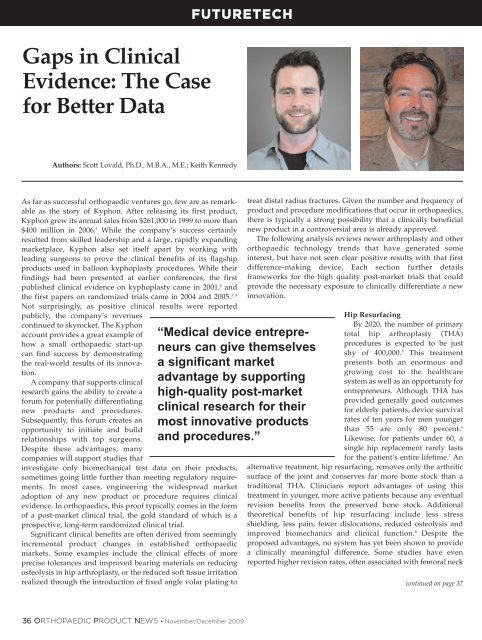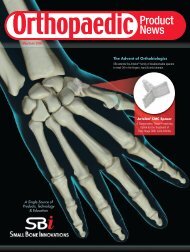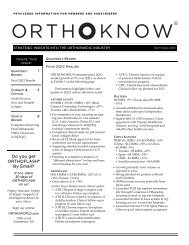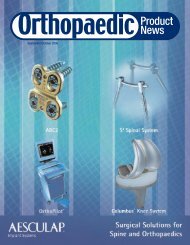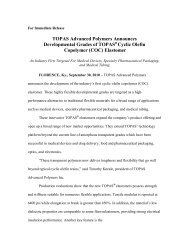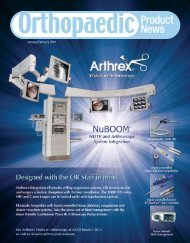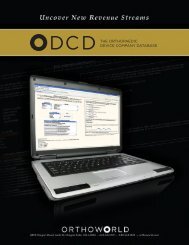Hip & Knee Surgery - Orthoworld
Hip & Knee Surgery - Orthoworld
Hip & Knee Surgery - Orthoworld
Create successful ePaper yourself
Turn your PDF publications into a flip-book with our unique Google optimized e-Paper software.
Gaps in ClinicalEvidence: The Casefor Better DataFUTURETECHAuthors: Scott Lovald, Ph.D., M.B.A., M.E.; Keith KennedyAs far as successful orthopaedic ventures go, few are as remarkableas the story of Kyphon. After releasing its first product,Kyphon grew its annual sales from $261,000 in 1999 to more than$400 million in 2006. 1 While the company’s success certainlyresulted from skilled leadership and a large, rapidly expandingmarketplace, Kyphon also set itself apart by working withleading surgeons to prove the clinical benefits of its flagshipproducts used in balloon kyphoplasty procedures. While theirfindings had been presented at earlier conferences, the firstpublished clinical evidence on kyphoplasty came in 2001, 2 andthe first papers on randomized trials came in 2004 and 2005. 3, 4Not surprisingly, as positive clinical results were reportedpublicly, the company’s revenuescontinued to skyrocket. The Kyphonaccount provides a great example ofhow a small orthopaedic start-upcan find success by demonstratingthe real-world results of its innovation.A company that supports clinicalresearch gains the ability to create aforum for potentially differentiatingnew products and procedures.Subsequently, this forum creates anopportunity to initiate and buildrelationships with top surgeons.Despite these advantages, manycompanies will support studies thatinvestigate only biomechanical test data on their products,sometimes going little further than meeting regulatory requirements.In most cases, engineering the widespread marketadoption of any new product or procedure requires clinicalevidence. In orthopaedics, this proof typically comes in the formof a post-market clinical trial, the gold standard of which is aprospective, long-term randomized clinical trial.Significant clinical benefits are often derived from seeminglyincremental product changes in established orthopaedicmarkets. Some examples include the clinical effects of moreprecise tolerances and improved bearing materials on reducingosteolysis in hip arthroplasty, or the reduced soft tissue irritationrealized through the introduction of fixed angle volar plating to“Medical device entrepreneurscan give themselvesa significant marketadvantage by supportinghigh-quality post-marketclinical research for theirmost innovative productsand procedures.”treat distal radius fractures. Given the number and frequency ofproduct and procedure modifications that occur in orthopaedics,there is typically a strong possibility that a clinically beneficialnew product in a controversial area is already approved.The following analysis reviews newer arthroplasty and otherorthopaedic technology trends that have generated someinterest, but have not seen clear positive results with that firstdifference-making device. Each section further detailsframeworks for the high quality post-market trials that couldprovide the necessary exposure to clinically differentiate a newinnovation.<strong>Hip</strong> ResurfacingBy 2020, the number of primarytotal hip arthroplasty (THA)procedures is expected to be justshy of 400,000. 5 This treatmentpresents both an enormous andgrowing cost to the healthcaresystem as well as an opportunity forentrepreneurs. Although THA hasprovided generally good outcomesfor elderly patients, device survivalrates of ten years for men youngerthan 55 are only 80 percent. 6Likewise, for patients under 60, asingle hip replacement rarely lastsfor the patient’s entire lifetime. 7 Analternative treatment, hip resurfacing, removes only the arthriticsurface of the joint and conserves far more bone stock than atraditional THA. Clinicians report advantages of using thistreatment in younger, more active patients because any eventualrevision benefits from the preserved bone stock. Additionaltheoretical benefits of hip resurfacing include less stressshielding, less pain, fewer dislocations, reduced osteolysis andimproved biomechanics and clinical function. 8 Despite theproposed advantages, no system has yet been shown to providea clinically meaningful difference. Some studies have evenreported higher revision rates, often associated with femoral neckcontinued on page 3736 ORTHOPAEDIC PRODUCT NEWS • November/December 2009


